Painting outside walls is an effective way to add colour that transforms the exterior of your house. Whether you’re looking to create cohesive flow from the inside or experiment with bolder colours, find the perfect shade in our extensive colour palette.
For painting an exterior brick wall or refreshing an existing outdoor paint finish, we recommend using our Intelligent Masonry Paint, which is available in almost all Little Greene colours. This quick-drying, water-based masonry paint can be used to achieve a long-lasting, smooth matt finish on brick, stone or rendered walls. Extremely durable, it will last at least 15 years on exterior walls before repainting is required*.
Our Masonry Paint also benefits from being highly dirt-resistant, with anti-fungal and anti-ageing properties that will ensure your home exteriors stay looking beautiful for longer.
Learn more about our Intelligent Masonry Paint.
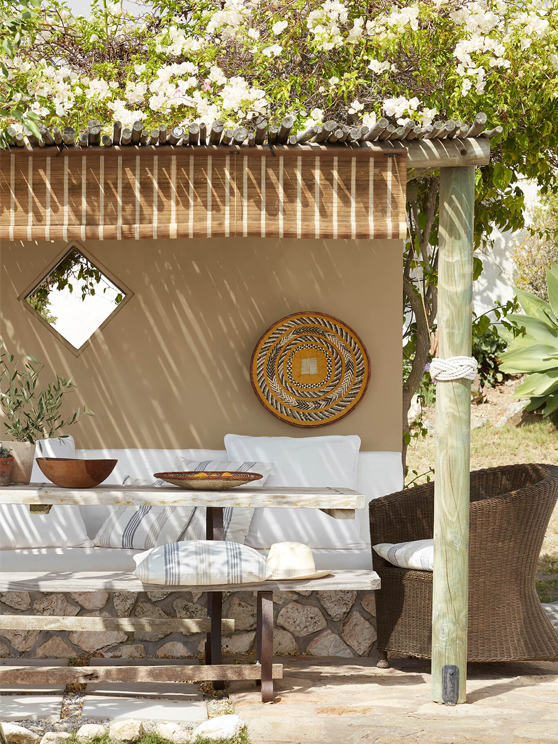
Wall: Lute, Seat: Flint
Follow our step by step guide to painting an exterior wall
What to consider before you start painting exterior walls
Make sure that the weather provides good conditions for painting. The ambient temperature should be above 5°C with no risk of rain during application or drying. Avoid painting in full sun or on surfaces that are already warm as this will affect the way the paint dries.
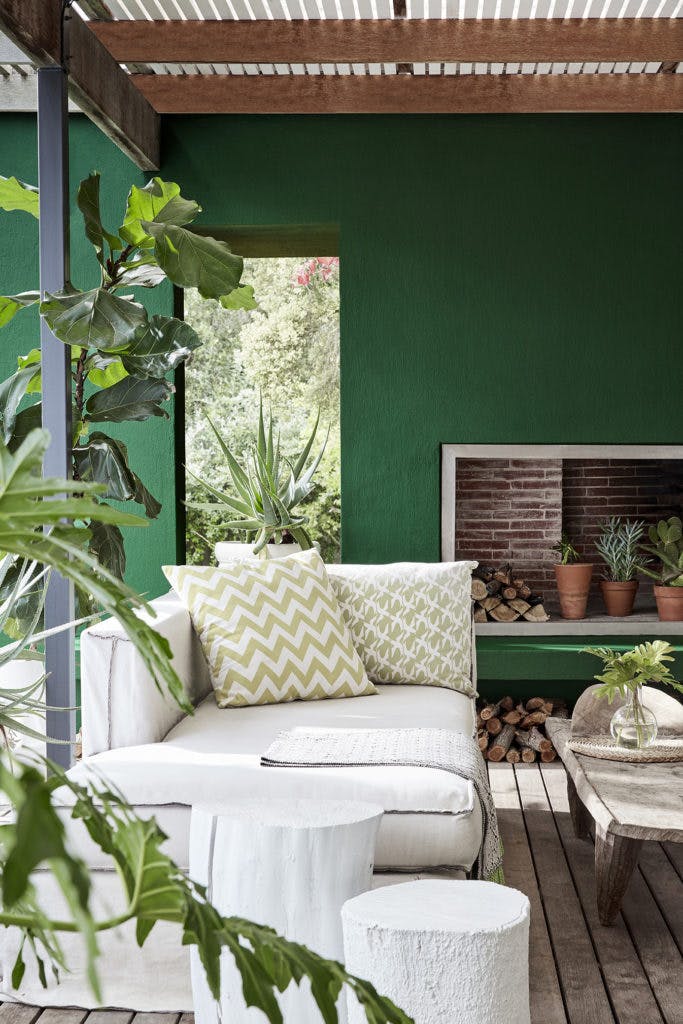
Wall: Puck, Tree Stumps: Aquamarine Pale, Beam Support Pole: Pompeian Ash
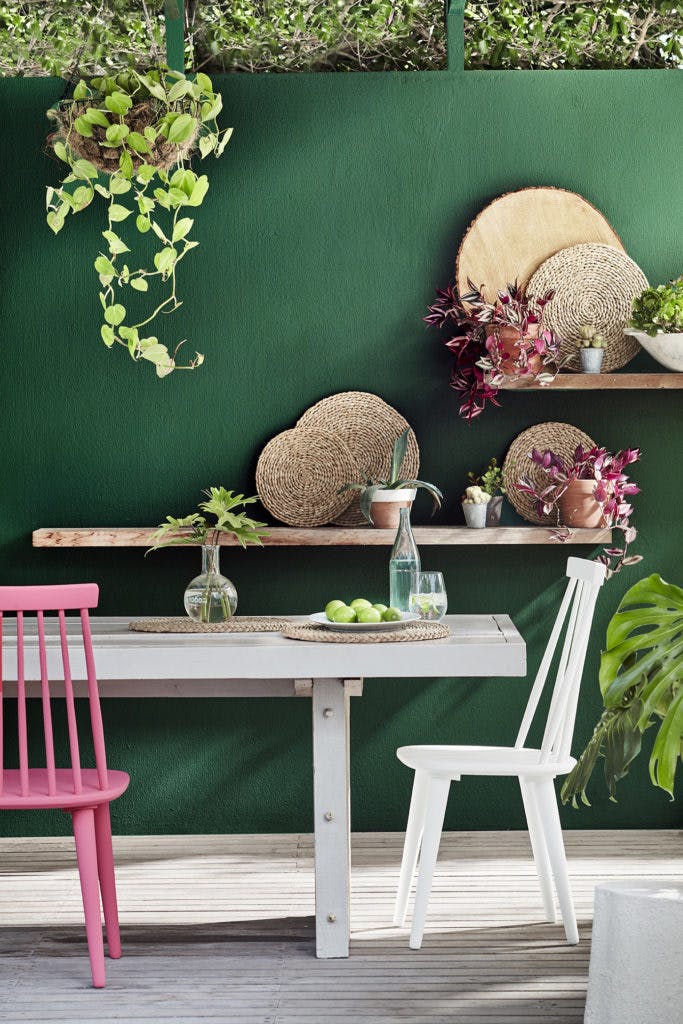
Wall: Puck, Table: French Grey, Left Chair: Carmine, Right Chair: French Grey – Mid
How to prepare exterior walls for painting
Preparing render, brick or cement block work:
Ensure that the exterior surface is clean, dry and grease free before brushing down the surface to remove any loose material.
Preparing previously painted exterior walls:
- Ensure that the surface is clean, dry and grease free. Brush down the wall to remove any loose or flaking paintwork.
- Replace any loose mortar or render. Make sure to fill and repair any cracks with exterior grade filler before you start the project.
- If the surface of your outside wall has become powdery, brush it down and treat it with a masonry stabilising solution before painting.
- Treat areas with any fungal growth with a fungicidal wash or 25% solution of household bleach, followed by thorough cleaning.

Wall: Linen Wash, Window Frame: Loft White, Table: Smalt, Chair: Bone China Blue
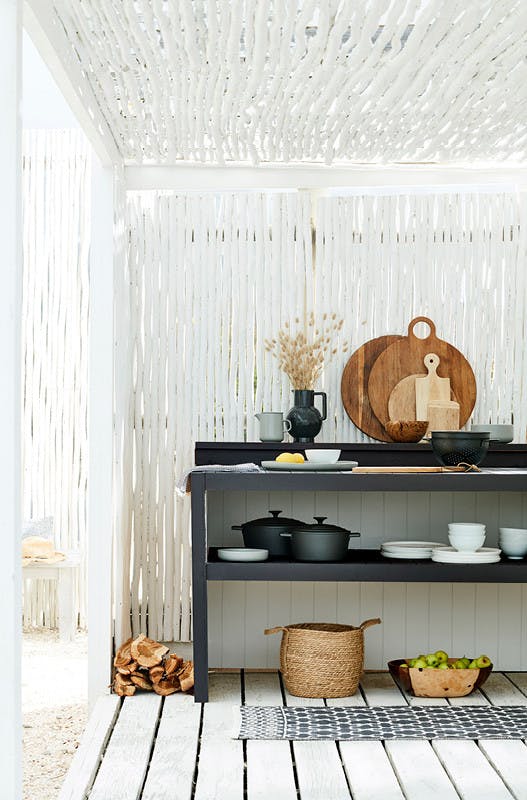
Painted Bamboo Wall & Ceiling: Loft White, Kitchen Unit: Lamp Black & Loft White
How to paint exterior walls?
Follow these steps for painting new render, brick, or cement block work, or for painting over an existing finish:
- On smooth surfaces, use either a high-quality, synthetic bristle brush or a short nap, wool blend roller for the best finish. Ensure that the brush is suitably sized for the project. For textured surfaces, select a roller with a longer nap length to ensure even and thorough coverage.
- Apply a primer coat of Intelligent Masonry Paint. Add 5 to 25% (v/v) volume of clean water, depending upon the porosity of the substrate. Stir the paint mixture thoroughly before use and make sure to paint out even strokes for smooth coverage.
- After waiting four hours for the primer coat to dry, apply the first full coat of Masonry Paint (without watering down). Make sure to stir the paint again before application.
- For the best finish, keep final brush strokes all in the same direction. Never go over paint that has already begun to dry as this will disrupt the smooth finish.
- Allow four hours before applying the second full coat of Intelligent Masonry Paint.

Exterior Painting Tips
- New brushes should be conditioned by washing them in clean water and thoroughly drying with a clean, lint free, cloth.
- Avoid immersing the brush too far into the paint to prevent paint from entering the ferrule.
- Avoid drips and splashes by not overloading the brush.
- Remember to allow the paint to dry fully, with four hours between each coat.
Exterior walls inspiration
There are countless ways that you could introduce colour to your exterior walls and fill your outside space with personality.
Outside living spaces are the ideal canvas to experiment with bolder shades and create an energetic, sociable entertaining space. For something more subtle, use green tones that blend beautifully with their natural surroundings. Or carry your neutral paint palette outdoors to create seamless flow between the outside and in.
Explore our inspiration gallery and find ideas to create your ideal exterior scheme.
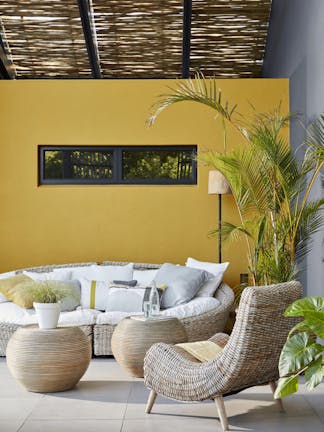
Yellow-Pink is a vibrant, earthy yellow which brings a playful feel to this outdoor seating area. Pair with Scree and Lamp Black to allow the bold colour to remain the focal point.
Left Wall: Yellow Pink
Right Wall: Scree
Window Frame: Lamp Black

Air Force Blue provides a beautiful contrast to natural greenery. Add a highlight of colour by painting a piece of wooden furniture in Mister David to bring personality to the scheme.
Back Wall: Air Force Blue
Table: Mister David
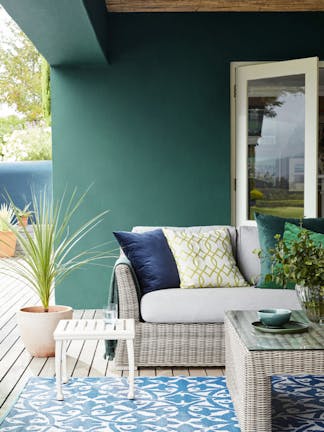
The sumptuous jewel tones, Puck and Mid Azure Green, pair well with natural wood accessories and terracotta pots. This combination creates a bold outdoor dining space, using green tones that sit effortlessly amongst nature for a restful setting.
Wall: Mid Azure Green
Far Wall: Air Force Blue
Window Frame: Slaked Lime - Mid
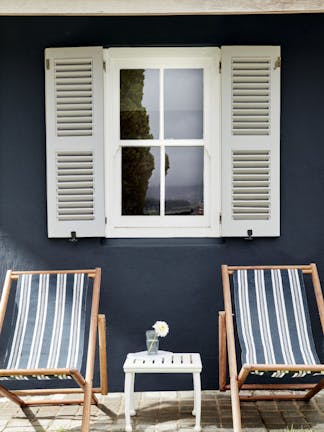
Darker colours, such as Basalt and Obsidian Green, can be used to create the feeling of a secluded spot in the shade. These deep shades are perfect for a quiet, relaxing corner of the garden.
Wall: Basalt
Shutters: Inox
Window Frame: Loft White
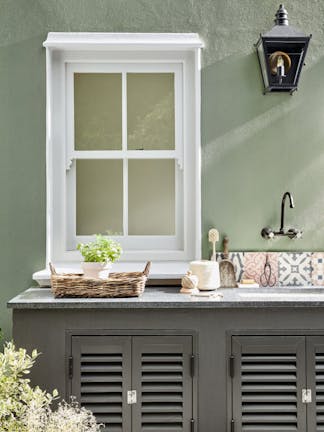
Boringdon Green brings a fresh, verdant feel to this exterior kitchen. Pair with woodwork painted in Wood Ash to keep the scheme bright and uplifting, and introduce Pompeian Ash for a sophisticated element.
Walls: Boringdon Green
Window Frame: Wood Ash
Cabinet: Pompeian Ash
Discover more exterior inspiration in our image gallery.
**Suitable preparation is necessary to ensure full longevity of all paint finishes. See our technical data sheets for further information.

